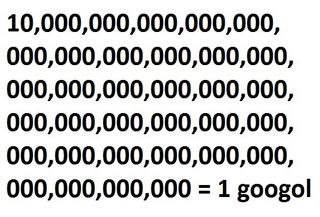Googol, Googolplex - & Google

Googol is a mathematical term to describe a huge quantity. It is not an incorrect spelling of the search engine giant’s name, Google — actually, it's the other way around. Googol, a quantity that surpasses even the number of hydrogen atoms in the observable universe, is a number dating back to the mid-1900s and is still used by mathematicians today.
Silly name for a silly sum
Googol is the label for 10 to the hundredth power (10100), or 1 followed by 100 zeros. Invented by Edward Kasner, the American mathematician referenced the quantity extensively in his 1940 book, "Mathematics and the Imagination." Kasner intended the number to serve as an example for students in showing how a number could be so incredibly large, it could baffle their minds.
While the term wasn’t more universally accepted and used until his book’s publishing, Kasner dated its creation to 1920 when he asked his 9-year-old nephew, Milton Sirotta, what he should call the number. Milton appropriately responded that such a silly sum required an equally silly name, from which the term "googol" was coined.
Googolplex
After naming googol, Milton proposed the further term of "googolplex," describing it as “one, followed by writing zeros until you get tired.” Rather than gauging a mathematician’s skill by their endurance in writing zeros, Kasner adopted a more formal interpretation of 10 followed by googol zeros, as opposed to a googol’s 100 zeros. To quantify a googolplex, astronomer and astrophysicist Carl Sagan gave the example of filling the entire volume of the observable universe with fine dust particles roughly 1.5 micrometers in size. From this, the total number of different combinations in which these particles could be arranged would equal approximately one googolplex.
Ginormous numbers
For its time, googol was the largest known number. Since the invention of the supercomputer, even larger numbers can be easily calculated, such as Graham’s number or Skewes’ number. For example, a centillion, a one and 303 zeros, is one of many large numbers. While the creation and naming of such large numbers is readily possible for any non-mathematician, their invention requires a specific purpose as opposed to an arbitrary notion.
Neither googol nor googolplex truly has any mathematical significance beyond acting as reference points for visualizing large numbers. For example, such numbers are used to speculate on things like the number of particles in the universe, the total number of chess game variances possible, or even 70 factorial. In other words, numbers as large as, even larger than, googols and googolplexes are used to quantify potential rather than physical things, thus increasing the potential application. In mathematical circles, their use is likely to be much more often than in everyday life, and only to quantify extremely large bodies of data.
Googol and Google
Larry Page and Sergey Brin, two of the founders of Google, grew up fascinated with mathematics and decided to name their company after the number. As the early Google team searched available domain names, the Stanford graduate student at the computer accidentally typed googol as “google” and the name stuck. While Google is a misspelling of googol, the company is based upon the same mathematical principles, choosing even to name Google’s headquarters in Mountain View as Googleplex.
Related:
Sign up for the Live Science daily newsletter now
Get the world’s most fascinating discoveries delivered straight to your inbox.
